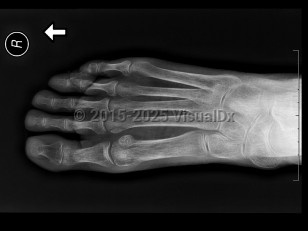Osteoporosis
Alerts and Notices
Important News & Links
Synopsis
Osteoporosis is a metabolic bone disease characterized by progressively declining bone density with decreasing bone strength and structure, resulting in increased fracture risk, especially vertebral and hip fractures. Fracture is the only clinical manifestation. The condition begins when osteoclast function (bone resorption) occurs more than osteoblast function (bone formation). This results in increased and irreversible bone porosity in the cortical and cancellous (trabeculae) osseous tissue. Risk factors include advancing age, female sex, and postmenopausal status. Corticosteroid use, especially long-term use, can be an important predisposing factor for osteoporosis.
Osteoporosis is classified into two categories, primary and secondary. Primary is the most common and includes postmenopausal, age-related, and idiopathic osteoporosis. Secondary refers to bone loss caused by an underlying condition such as cancer, chronic obstructive pulmonary disease, certain drugs, chronic kidney disease, and endocrine disorders.
Treatment attempts to maintain function, current bone mass, and prevent fractures and pain. It includes calcium and vitamin D supplementation, prescription therapy, and lifestyle changes. Risk stratification including presence of fractures, T score, and fracture risk assessment tool (FRAX) score can help determine treatment thresholds.
Prevention of fractures with bisphosphonates has been shown most clearly in patients with osteoporosis, which is defined either by a bone-density T score of less than −2.5 or by the presence of prevalent vertebral fractures. The efficacy of continuation of bisphosphonate therapy after 5 years is still under consideration. Whether bisphosphonates are efficacious in patients with osteopenia alone is uncertain.
Osteoporosis is classified into two categories, primary and secondary. Primary is the most common and includes postmenopausal, age-related, and idiopathic osteoporosis. Secondary refers to bone loss caused by an underlying condition such as cancer, chronic obstructive pulmonary disease, certain drugs, chronic kidney disease, and endocrine disorders.
Treatment attempts to maintain function, current bone mass, and prevent fractures and pain. It includes calcium and vitamin D supplementation, prescription therapy, and lifestyle changes. Risk stratification including presence of fractures, T score, and fracture risk assessment tool (FRAX) score can help determine treatment thresholds.
Prevention of fractures with bisphosphonates has been shown most clearly in patients with osteoporosis, which is defined either by a bone-density T score of less than −2.5 or by the presence of prevalent vertebral fractures. The efficacy of continuation of bisphosphonate therapy after 5 years is still under consideration. Whether bisphosphonates are efficacious in patients with osteopenia alone is uncertain.
Codes
ICD10CM:
M81.0 – Age-related osteoporosis without current pathological fracture
M81.8 – Other osteoporosis without current pathological fracture
SNOMEDCT:
64859006 – Osteoporosis
M81.0 – Age-related osteoporosis without current pathological fracture
M81.8 – Other osteoporosis without current pathological fracture
SNOMEDCT:
64859006 – Osteoporosis
Differential Diagnosis & Pitfalls

To perform a comparison, select diagnoses from the classic differential
Subscription Required
Drug Reaction Data
Subscription Required
References
Subscription Required
Last Updated:01/03/2024
Osteoporosis

